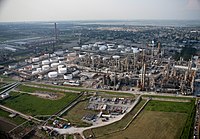
Photo from wikipedia
Both the global steel and chemical industries contribute largely to industrial greenhouse gas (GHG) emissions. For both industries, GHG emissions are strongly related to the consumption of fossil resources. While… Click to show full abstract
Both the global steel and chemical industries contribute largely to industrial greenhouse gas (GHG) emissions. For both industries, GHG emissions are strongly related to the consumption of fossil resources. While the chemical industry often releases GHGs as direct process emissions, steel mills globally produce 1.78 Gt of off-gases each year, which are currently combusted for subsequent heat and electricity generation. However, these steel mill off-gases consist of high value compounds, which also can be utilized as feedstock for chemical production and thereby reduce fossil resource consumption and thus GHG emissions. In the present work, we determine climate-optimal utilization pathways for steel mill off-gases. We combine a nonlinear, disjunctive model of the steel mill off-gas separation system with a large-scale linear model of the chemical industry to perform environmental optimization. The results show that the climate-optimal utilization of steel mill off-gases depends on electricity's carbon footprint: For the current electricity grid mix, methane, hydrogen, and synthesis gas are recovered as feedstocks for conventional chemical production and enable a methanol-based chemical industry. For low electricity footprints in the future, the separation of steel mill off-gases supports CO2-based production processes in the chemical industry, supplying up to 30% of the required CO2. By coupling the global steel and chemical industry, industrial GHG emissions can be reduced by up to 79 Mt CO2-equivalents per year. These reductions provide up to 4.5% additional GHG savings compared to a stand-alone optimization of the two industries, showing a limited potential for this industrial symbiosis.
Journal Title: Environmental science & technology
Year Published: 2022
Link to full text (if available)
Share on Social Media: Sign Up to like & get
recommendations!